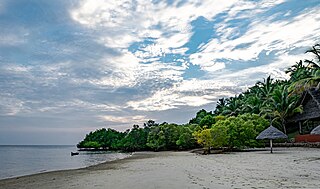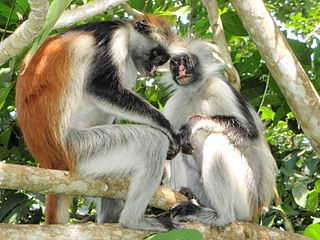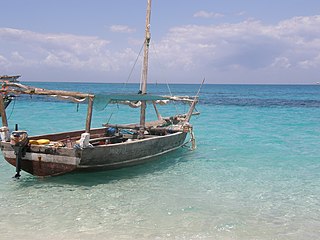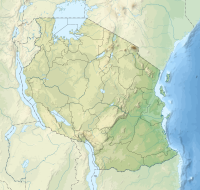
Pemba Island is a Tanzanian island forming part of the Zanzibar Archipelago, lying within the Swahili Coast in the Indian Ocean.

Mafia Island or Chole Shamba is an island of The Mafia Archipelago located in Mafia District in the southern Pwani Region of Tanzania across the Mafia Channel. The island is the third largest in Tanzanian ocean territory, but is not administratively included within the semi-autonomous region of Zanzibar, which has been politically separate since 1890. Mafia Island forms the largest part of Mafia District, one of the six administrative districts in the Pwani Region. As the Mafia Archipelago's main island, it's sometimes called Chole Shamba, meaning Chole farmlands in Swahili. This is in opposition to the historic settlement of Chole Mjini on Chole Island inside Mafia Bay. The island's population is over 65,000. The economy is based on fishing, subsistence agriculture and the market in Kilindoni. The island attracts some tourists, mainly scuba divers, birdwatchers, game fishermen, and people seeking relaxation.

Coral sand is a form of aragonite sand particles originating in tropical and sub-tropical marine environments primarily from bioerosion of limestone skeletal material of marine organisms. Often, this is due to corallivores, such as parrotfish, which excrete sand after digestion. However, the term "coral" in coral sand is used loosely in this sense to mean limestone of recent biological origin; corals are not the dominant contributors of sand particles to most such deposits. Rather, coral sand is a mix of coral and/or remnant skeletal fragments of foraminifera, calcareous algae, molluscs, and crustaceans. Because it is composed of limestone, coral sand is acid-soluble.

Mafia Island Marine Park is a protected marine park with the IUCN category VI around the Mafia Archipelago in the Indian Ocean's sea of Zanj. It is administratively located in the jurisdiction Mafia District of Pwani Region in Tanzania.

Maziwi island officially, The Maziwe Island Marine Reserve is a unvegetated, protected island surrounded by coral reefs located about 8 kilometres (5.0 mi) south east of the town of Pangani off the northern coast of Tanga Region in Tanzania. The island is administered under Mwera ward of Pangani District. However, it is currently under the Tanga Marine Reserves System. It became a nature reserve in 1975. At one time the island was larger than its present area and was well-vegetated but with the loss of its coconut trees and scrub cover, it has suffered erosion and is now sometimes completely immersed at the time of the highest tides. Green sea turtles no longer nest on the island, but it is visited by numerous sea birds. The sea contains many species of coral and over two hundred species of fish. The reserve has received little active conservation work but management is now supported by levying a small fee on tourists which is used to compensate local fishermen for loss of income.

The wildlife of Zanzibar consists of terrestrial and marine flora and fauna in the archipelago of Zanzibar, an autonomous region of Tanzania. Its floral vegetation is categorized among the coastal forests of eastern Africa as the Southern Zanzibar-Inhambane coastal forest mosaic and the Northern Zanzibar-Inhambane coastal forest mosaic. Its faunal species are mostly small animals, birds, and butterflies.

Mafia District Council is one of eight administrative districts of Pwani Region in Tanzania. It administers not only the main Mafia Island but the entire Mafia Archipelago. The District covers an area of 642.6 km2 (248.1 sq mi). The Sea of Zanj completely encircles the District. Rufiji District is located on the other side of the Mafia Channel to the west. The district is comparable in size to the land area of Saint Lucia. The town of Kilindoni serves as its administrative capital. The District is home to the largest concentration of Whale Sharks in Africa, Mafia Island Marine Park, Historic Chole Island Ruins, Kisimani Mafia and Kua Ruins; and Mlola Forest Reserve. According to the 2012 Tanzania National Census, the population of the District was 46,438.
Latham Island, known locally as Fungu Kizimkazi is an isolated island 43 km east of Kigamboni District in the Dar es Salaam Region of Tanzania. The island geographically considered a part of the Zanzibar Archipelago of Tanzania, it was once politically under the Sultanate of Zanzibar from 1898 to 1963. Currently, the island is administered by the United Republic of Tanzania.
The East African coral coast is a marine ecoregion along the eastern coast of Africa. It extends along the coasts of Kenya, Tanzania, and northern Mozambique, from Lamu in Kenya to Angoche in Mozambique. It adjoins the Northern Monsoon Current Coast ecoregion to the north, and the Bight of Sofala/Swamp Coast ecoregion to the south.

Juani Island is an island of the Mafia Archipelago located in Jibondo ward of Mafia District in southern Pwani Region of Tanzania.

Kua or Ruins of Kua is a Medieval Swahili, National Historic Site located in Jibondo ward of Mafia District in Pwani Region of Tanzania. The site is located on Juani Island of the Mafia Archipelago. As of 2016, the site is currently on the list of 50 at-risk cultural heritage sites in 36 countries.
Chole Island or Chole Mjini Island is an island of the Mafia Archipelago located in Jibondo ward of Mafia District in southern Pwani Region of Tanzania. A fossil coral reef that was uncovered at the conclusion of the last ice age, around 12,000 years ago, served as the foundation for the 2.26 km2 island of Chole. It has been a part of the Mafia Island Marine Park for a very long time.
Bwejuu Island is an island of the Mafia Archipelago located in Kilindoni ward of Mafia District in southern Pwani Region of Tanzania. After Jibondo Island, which is to its east, the island is the fourth largest in the archipelago. Mafia Island is to the east, and the Mafia Channel is to the west and south of the island.
Miewi Island is an island of the Mafia Archipelago located in Baleni ward of Mafia District in southern Pwani Region of Tanzania. The island has a small islet to the south east. The Island is located at the mouth of Chole Bay and is bordered to the north is Mafia Island. To the south is Juani Island and to the east is the sea of Zanj. Many locations, particularly off Miewi island, were used for the majority of the sport fishing industry in the islands. However, Tutia reef was regarded to be the best fishing location.
Niororo Island or spelled in some maps as Nyororo Island is an island of the Mafia Archipelago located in Kirongwe ward of Mafia District in southern Pwani Region of Tanzania. The island has a small islet to the south east. The Island is located north of Shungumbili Island and is bordered to the north is Mafia Island. To the south is Juani Island and to the east is the sea of Zanj. Many locations, particularly off Miewi island, were used for the majority of the sport fishing industry in the islands. However, Tutia Reef was regarded to be the best fishing location.
Tutia Reef is a system of protected coral reefs inside the Mafia Island Marine Park (MIMP) with the IUCN category II designation. The reef is located on Tanzania's Mafia Archipelago of Mafia District in southern Pwani Region of Tanzania. Tutia Reef is rated as the country's top spot for sport fishing, however the reef is also the site some of the worst coral bleaching events in history in 1998. The reef is located south west of Jibondo Island inside the Mafia Channel.

Bagamoyo Historic Town or Bagamoyo Stone Town, is the historic section of Bagamoyo town in Bagamoyo District of Pwani Region. Due to its historic significance spanning centuries and empires, Old Bagamoyo is a National Historic Site of Tanzania. The settlement was first inhabited in the 8th century as a Zaramo village and then a Swahili stone settlement, satellite to Kaole. One of the most significant trading hubs on the coast of East Africa, Bagamoyo served as the last halt for ivory caravans making their way on foot from Lake Tanganyika to Zanzibar.

Kwale Island is a protected island located in Fumba ward of Mjini District in Mjini Magharibi Region, Tanzania. The island is included in the marine conservation area of Menai Bay.











